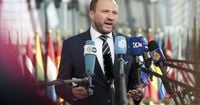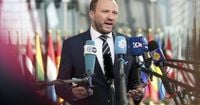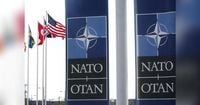When three Russian fighter jets reportedly entered Estonia's airspace without authorization on Friday, September 19, 2025, alarm bells rang not just in Tallinn but across NATO’s 32 member countries. The intrusion, which lasted 12 tense minutes, marked the latest in a series of provocative aerial incidents along the alliance’s eastern flank. Just nine days prior, around 20 Russian drones had breached Polish airspace, raising urgent questions about NATO’s preparedness and unity in the face of mounting threats from Moscow.
In response to these escalating tensions, Estonia formally requested consultations under Article 4 of NATO’s founding treaty. On Tuesday, September 23, 2025, ambassadors from every NATO country convened at the alliance’s Brussels headquarters, a gathering that underscored both the gravity of the situation and the unique mechanisms NATO employs to address such crises. According to the Associated Press, Russia’s Defense Ministry flatly denied Estonia’s accusation, but the incident nevertheless catalyzed a rare diplomatic move: Article 4 has only been invoked nine times since NATO’s creation in 1949, and this marks the second such consultation in just two weeks.
So, what exactly does invoking Article 4 mean? As explained by the Washington Treaty, Article 4 is brief but significant: “The Parties will consult together whenever, in the opinion of any of them, the territorial integrity, political independence or security of any of the Parties is threatened.” In practice, this provision allows any member state to raise the alarm, compelling the alliance to gather, discuss, and coordinate responses to perceived threats. Unlike Article 5—NATO’s famed collective defense clause, which declares that an attack on one is an attack on all—Article 4 does not automatically trigger military or political action. Instead, it puts urgent matters squarely on NATO’s agenda, encouraging allies to react in a unified manner to situations flagged by a fellow member.
Bob Deen, an analyst at the Clingendael think tank in The Hague, told The Associated Press that Article 4 is “designed to promote better coordination and understanding within the alliance on external threats. It gives all allies the opportunity to urgently put certain threats or developments on the agenda of the North Atlantic Council.” In other words, Article 4 is less a tripwire and more a pressure valve—an early warning system that helps the alliance stay nimble and responsive amid fast-changing security landscapes.
Estonia’s move to invoke Article 4 this week followed a similar request from Poland, which had called for consultations after the September 10 drone incursion. The rapid sequence of events highlights just how volatile NATO’s eastern border has become. In response to Poland’s request, NATO launched Operation Eastern Sentry two days later, deploying European aircraft and bolstering defensive systems along the region. While the alliance stopped short of direct military engagement, the operation demonstrated a clear willingness to reinforce its presence and deter further aggression.
It’s worth noting that Article 4 is a tool that’s been used sparingly—just nine times in more than seven decades. Yet, its recent uptick reflects the growing unease among NATO’s eastern members. Before the latest incidents, Poland had previously invoked Article 4 on March 3, 2014, in the wake of Russia’s annexation of Ukraine’s Crimean Peninsula. That moment marked a turning point for NATO, as Russia’s aggressive actions in Ukraine shattered longstanding assumptions about European security. Since then, the alliance has had to adapt to a more unpredictable and assertive Russia, with Article 4 serving as a key mechanism for dialogue and coordination.
According to NATO sources cited by BBC and The Associated Press, Article 4 consultations can lead to joint decisions or actions, but there’s no guarantee of a specific outcome. The talks are consensus-driven, meaning that all allies must agree before moving forward with any collective response. This system ensures that every member—regardless of size or military strength—has a voice at the table. However, it also means that decisive action can sometimes be elusive, especially when political interests diverge.
For many in the region, the recent airspace violations are more than just technical infractions—they’re a test of NATO’s credibility and resolve. While Russia’s Defense Ministry has denied both the Estonian and Polish accusations, the incidents fit a broader pattern of brinkmanship and intimidation. As the alliance’s eastern members grow increasingly anxious, the frequency of Article 4 consultations may well rise, signaling a new era of vigilance and solidarity.
Of course, Article 4 is not a prelude to war. As Bob Deen emphasized, “Article 4 is related to Article 5, but is not necessarily a ‘stepping stone.’” He explained, “Article 5 has only been invoked once, in response to the 9/11 attacks on the United States, immediately bypassing Article 4. In other words: Article 4 can be invoked without triggering Article 5, and vice versa.” This distinction is crucial. While Article 5 underpins NATO’s credibility as a mutual defense pact, it is a political commitment rather than a strict legal requirement. Each member retains the right to determine how it responds to an attack on another ally, allowing for flexibility in both diplomacy and defense.
The recent spate of Article 4 consultations has also prompted reflection on NATO’s decision-making processes. As the North Atlantic Council meets almost weekly, the alliance is constantly balancing the need for swift action with the imperative of consensus. This approach has its critics—some argue that it can lead to paralysis in moments of crisis—but it also ensures that every member’s concerns are heard and addressed.
Looking back, the history of Article 4 reveals its evolving role within the alliance. Turkey, for example, invoked Article 4 five times between 2003 and 2020 in response to threats emanating from Syria and Iraq. The recent cases involving Estonia and Poland, however, are rooted in the unique challenges posed by Russia’s military posture in Eastern Europe. As tensions continue to simmer, NATO’s ability to adapt and respond—whether through Article 4 consultations, military deployments, or diplomatic engagement—will be closely watched by allies and adversaries alike.
For now, the alliance’s message to Moscow is clear: any breach of NATO airspace, no matter how brief, will not go unnoticed or unaddressed. As the situation unfolds, the world will be watching to see whether NATO’s mechanisms for consultation and coordination are up to the task of safeguarding its members’ sovereignty and security in an increasingly unpredictable world.


